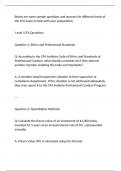Class notes
Chartered Financial Analyst
- Course
- Institution
The Chartered Financial Analyst (CFA) designation, offered by the CFA Institute, is a prestigious credential for investment professionals. It signifies expertise in investment analysis, portfolio management, and ethical standards. The program comprises three rigorous exams, covering topics such as ...
[Show more]



